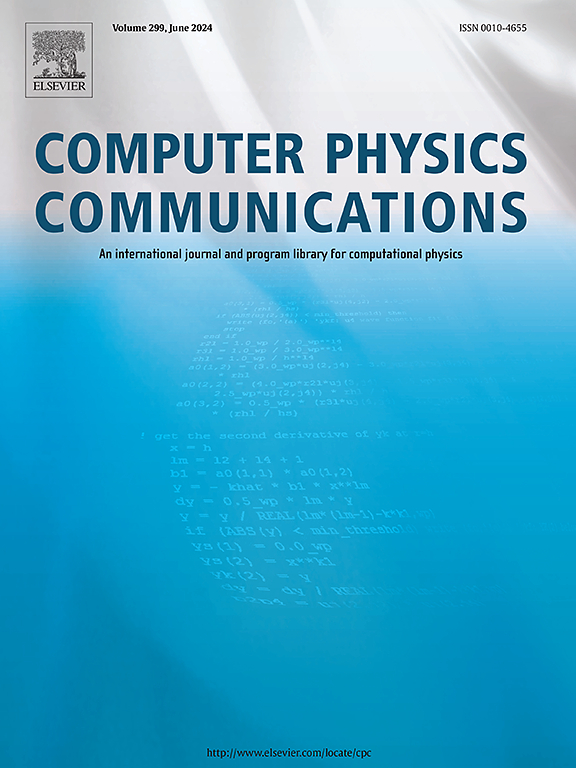A coupled finite volume-lattice Boltzmann method for incompressible internal flows
IF 3.4
2区 物理与天体物理
Q1 COMPUTER SCIENCE, INTERDISCIPLINARY APPLICATIONS
引用次数: 0
Abstract
We present, test and validate a two-way framework that couples macroscopic and mesoscopic methods to simulate incompressible internal flows spanning a range of spatial and temporal scales. Specifically, the unstructured finite volume method (FVM) is coupled to the structured lattice Boltzmann method (LBM). The multi-resolution domain is resolved through two strategies, i.e., non-Cartesian FVM meshes and multi-level refinement LBM using octree-like Cartesian grid points. The coupled approach divides the entire computational domain into sub-regions, each solved independently. Information exchange between these sub-regions is facilitated by a coupling library that introduces spatial interpolation and temporal iteration schemes for different scales. The effectiveness of the proposed coupled strategy is assessed against well-documented benchmark tests and further examined in scenarios involving flow over artificial porous media. The results obtained by the new coupled framework show excellent agreement with reference data and exhibit strong parallel performance for tests on up to 32768 CPU cores, demonstrating the potential of the approach for large-scale investigations.
Program summary
Program Title: code_saturne-LUMA-coupling
CPC Library link to program file: https://github.com/yangzhou-10/code_saturne-LUMA-coupling
LUMA licensing provisions: Apache License 2.0
LUMA programming language: C++
code_saturne licensing provisions: GNU General Public License v2.0
code_saturne programming language: C, C++
Nature of problem: Traditional single CFD numerical methods face significant challenges in multiscale flow simulations. Numerical methods, relying on the continuum medium hypothesis, often overlook or approximate microscale effects using empirical schemes. Conversely, micro/mesoscopic methods are constrained by the computational resources required to simulate the entire domain comprehensively.
Solution method: A coupled FVM-LBM scheme is developed wherein the computational domain is partitioned into macroscopic and microscopic sub-regions, solved independently using the FVM and LBM, respectively. Communication between these sub-regions is facilitated via a coupling interface implemented using the PLE coupling library. The LBM code is developed within the LUMA package, while the FVM code is integrated into the framework of code_saturne. The PLE coupling library is embedded within the code_saturne package.
不可压缩内部流动的有限体积-晶格耦合玻尔兹曼方法
我们提出、测试并验证了一个双向框架,该框架结合宏观和介观方法来模拟跨越一系列空间和时间尺度的不可压缩内部流动。具体来说,将非结构有限体积法(FVM)与结构晶格玻尔兹曼法(LBM)耦合。通过非笛卡尔FVM网格和使用八叉形笛卡尔网格点的多级细化LBM两种策略进行多分辨率域的分解。耦合方法将整个计算域划分为子区域,每个子区域独立求解。这些子区域之间的信息交换由一个耦合库促进,该库引入了不同尺度的空间插值和时间迭代方案。所提出的耦合策略的有效性通过充分记录的基准测试进行了评估,并在涉及人工多孔介质流动的情况下进一步进行了检查。新的耦合框架得到的结果与参考数据非常吻合,并且在多达32768个CPU核的测试中显示出强大的并行性能,表明了该方法在大规模研究中的潜力。程序摘要程序标题:code_saturne- luma - couplingcpc库链接到程序文件:https://github.com/yangzhou-10/code_saturne-LUMA-couplingLUMA许可条款:Apache License 2.0LUMA编程语言:c++ code_saturne许可条款:GNU通用公共许可证v2.0code_saturne编程语言:C, c++问题性质:传统的单一CFD数值方法在多尺度流动模拟中面临重大挑战。数值方法依赖于连续介质假设,经常忽略或近似使用经验方案的微观尺度效应。相反,微观/介观方法受到全面模拟整个领域所需的计算资源的限制。求解方法:提出了一种FVM-LBM耦合方案,将计算域划分为宏观子区域和微观子区域,分别使用FVM和LBM独立求解。这些子区域之间的通信通过使用PLE耦合库实现的耦合接口来实现。LBM代码在LUMA包中开发,而FVM代码集成到code_saturne框架中。PLE耦合库嵌入在code_saturne包中。
本文章由计算机程序翻译,如有差异,请以英文原文为准。
求助全文
约1分钟内获得全文
求助全文
来源期刊

Computer Physics Communications
物理-计算机:跨学科应用
CiteScore
12.10
自引率
3.20%
发文量
287
审稿时长
5.3 months
期刊介绍:
The focus of CPC is on contemporary computational methods and techniques and their implementation, the effectiveness of which will normally be evidenced by the author(s) within the context of a substantive problem in physics. Within this setting CPC publishes two types of paper.
Computer Programs in Physics (CPiP)
These papers describe significant computer programs to be archived in the CPC Program Library which is held in the Mendeley Data repository. The submitted software must be covered by an approved open source licence. Papers and associated computer programs that address a problem of contemporary interest in physics that cannot be solved by current software are particularly encouraged.
Computational Physics Papers (CP)
These are research papers in, but are not limited to, the following themes across computational physics and related disciplines.
mathematical and numerical methods and algorithms;
computational models including those associated with the design, control and analysis of experiments; and
algebraic computation.
Each will normally include software implementation and performance details. The software implementation should, ideally, be available via GitHub, Zenodo or an institutional repository.In addition, research papers on the impact of advanced computer architecture and special purpose computers on computing in the physical sciences and software topics related to, and of importance in, the physical sciences may be considered.
 求助内容:
求助内容: 应助结果提醒方式:
应助结果提醒方式:


